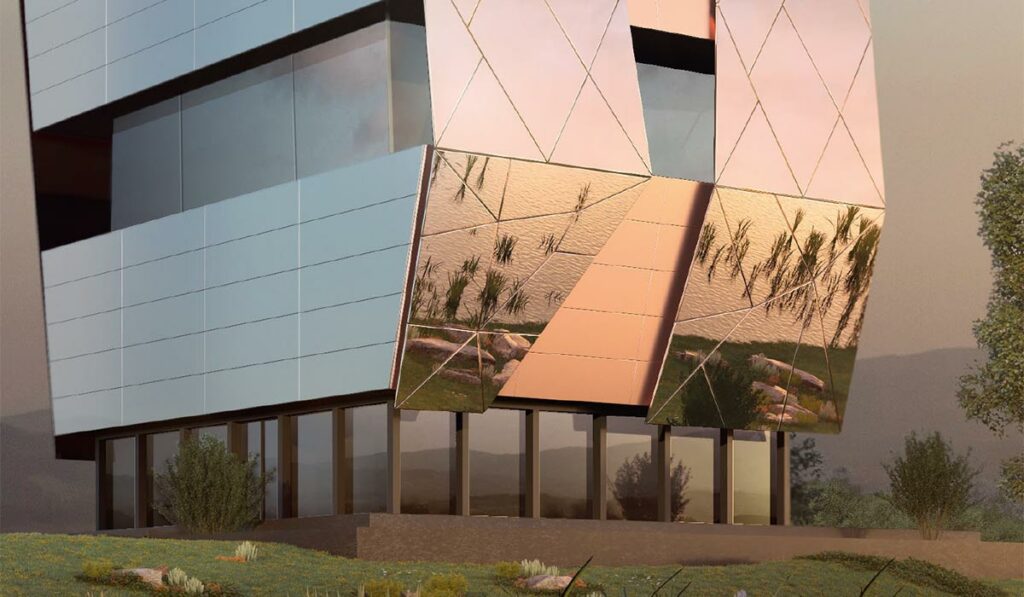Benefits of architectural aluminium in sustainable building design
In an ever-evolving landscape of architectural innovation, sustainable design has emerged as a driving force in shaping the future of the built environment. Among the multitude of materials available to architects, specially designed architectural aluminium stands out as a versatile, robust and environmentally conscious choice.
How architectural aluminium is shaping the future of sustainable buildings
Having spent more than 40 years supplying aluminium globally, we have seen the change in demand and need for innovation in architectural building design. In this article, we delve deeper into the benefits aluminium brings when shaping a sustainable, more resilient future.
Is aluminium sustainable?
In short, yes, aluminium is a leading choice when considering sustainable building materials, of course, provided that it is sourced, produced, and used in an environmentally responsible manner. Compared to other materials, aluminium has a relatively low embodied energy, which refers to the total energy consumed during extraction, processing, manufacturing, and transportation.
At Alanod, many of our products are manufactured from up to 90% recycled aluminium, helping us to meet our environmentally friendly manufacturing standards, generate fewer emissions and protect natural bauxite reserves.

The sustainable benefits of using aluminium in architecture
Whether it be creating a visually striking façade or solar shading systems, architectural aluminium offers unique properties in terms of not only aesthetics but also energy efficiency. Its adaptability and eco-friendly attributes make it a valuable asset in the pursuit of constructing resilient and environmentally responsible structures.
1. Aluminium is incredibly lightweight
One of the most desirable features of aluminium is its high strength-to-weight ratio. By using aluminium in the structure of a building, fewer materials will be required to support the load, resulting in reduced material costs without compromising on robustness. This achieves a quicker yet more streamlined installation process with less demand for resources (both material and labour-wise).
In terms of sustainability, the lightweight nature of aluminium means less fuel required for transportation and, therefore, fewer carbon emissions. Not only this, but lightweight structures also demand less energy for heating, cooling and overall climate control – which leads us smoothly to our next benefit.
2. Aluminium offers excellent energy efficiency
Aluminium is a fantastic investment for maximising energy efficiency, making it a must should you be tasked with designing a building focused on sustainability. As an effective conductor of heat, aluminium can be used in fenestration systems and cladding to achieve better insulation and reduce heat transfer between the interior and exterior. It absorbs and disperses heat, helping to regulate temperatures and save energy, which, in return, lowers carbon footprint.
In warmer locations, aluminium surfaces can be treated to enhance reflectivity and solar control. Specialist coatings on aluminium roofing or cladding can help reflect a significant portion of solar radiation, reducing heat absorption. This contributes to a cooler interior environment and lowers the demand for air conditioning, resulting in energy savings.
3. Aluminium is long-lasting with minimal maintenance
Both durable and resistant to corrosion, aluminium has become one of the most long-lasting building materials, able to withstand all elements without impacting structural integrity. This longevity reduces the need for frequent replacements or repairs, minimising the environmental impact associated with the manufacturing and disposal of building materials.
When it comes to maintenance, keeping aluminium in good condition couldn’t be simpler. Once treated (for example, anodised, painted or lacquered), aluminium will not corrode, rust or fade. This means only basic cleaning is required to maintain its original appearance. Not only this, but aluminium components are generally easier to handle during routine inspections or maintenance tasks, reducing the logistical challenges associated with upkeep.
4. Aluminium is fully customisable
While sustainability may be at the top of the agenda during the design process, choosing aluminium certainly doesn’t mean compromising aesthetics. As mentioned above, aluminium is lightweight, which allows architects to explore more innovative and creative designs. It can be easily manipulated and shaped into various forms, facilitating the creation of more intricate, striking structures that may not be feasible with heavier materials.
Along with shape and size, modern aluminium is also available in a vast range of colours. For instance, at Alanod, we regularly supply aluminium for ACM (aluminium composite material), which can be manufactured in many shades, from traditional metallic to bright solid colours.
5. Aluminium can be recycled and reused
Perhaps one of the most important sustainability traits of aluminium is its ability to be recycled and reused without losing its quality. In fact, studies show that recycling aluminium uses up to 95% less energy than producing it from scratch using raw materials. This means that once aluminium cladding, for example, reaches the end of its life on your building, you have peace of mind that it will be repurposed. Not only this, but you can also take a greener approach from the early stages by choosing quality recycled aluminium in your architectural design.

Using architectural aluminium today for a greener tomorrow
In the dynamic landscape of sustainable architecture, aluminium not only meets the demands of today but also paves the way for a more environmentally conscious tomorrow. Able to create visually striking structures while improving thermal efficiency, durability and longevity, aluminium is perfect for architects looking for a seamless blend of aesthetics and environmental responsibility.

